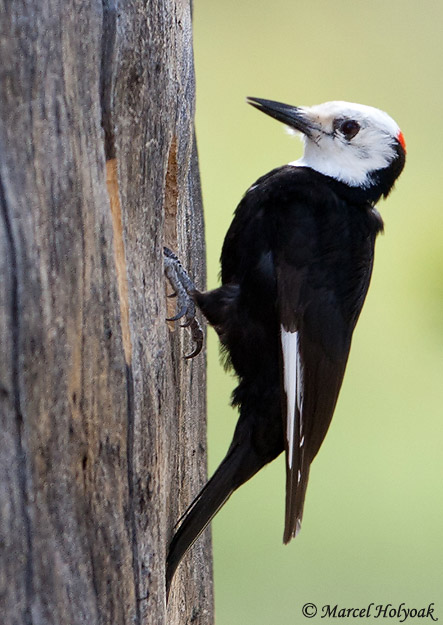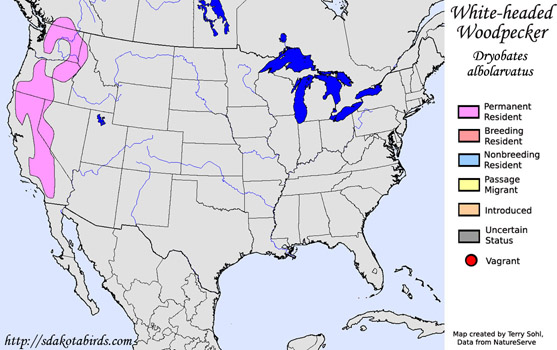| Length: 9 inches | Wingspan: 16 inches | Seasonality: Non-resident in South Dakota |
| ID Keys: Black body, white head, white patch on wings, male has red patch on back of head | ||
 The
White-headed Woodpecker is a unique species of pine forests of the far
western United States. They are not only the only woodpecker with
similar plumage, they are the only bird in North America with a white head
and a black body. They have a rather limited geographic range, as they
require large pine trees with heavy crops of pine seeds, as well as dead
trees, snags, and tree branches for nesting. While overall populations
currently are not threatened, habitat destruction and intensive forestry
activity have impacted the species in many areas.
The
White-headed Woodpecker is a unique species of pine forests of the far
western United States. They are not only the only woodpecker with
similar plumage, they are the only bird in North America with a white head
and a black body. They have a rather limited geographic range, as they
require large pine trees with heavy crops of pine seeds, as well as dead
trees, snags, and tree branches for nesting. While overall populations
currently are not threatened, habitat destruction and intensive forestry
activity have impacted the species in many areas.
Habitat: Found in mountainous pine forests of the West, using a variety of pine species. They are only rarely found in forests comprised of other conifer species.
Diet: Feeds heavily on pine seeds if available. Also feeds on insects and spiders.
Behavior: Much of the foraging of a White-headed Woodpecker consists of looking for pine cones and prying open the cones for the seeds inside. They will climb along the trunks and branches of conifer trees, looking for insects. They tend to be quieter and less obvious than many woodpeckers, as when foraging for wood-boring beetles and other insects, they pry bark away from the tree rather than actively hammering and chipping it.
Nesting: The nest of a White-headed Woodpecker is a cavity in a tree, with most nests placed in pine trees, but also sometimes in other trees. Bot the male and female will help to excavate the nest, with a new nest hole created each year. The female lays 3 to 6 eggs, and both parents help to incubate them. Both parents also help to tend to the young and feed them after they hatch.
Song: Has a long rattling, chattering call, as well as a crisp staccato pik call, typically given two or three times.
Migration: Considered non-migratory throughout its range. There may be some short-distance elevational movements, with birds moving to lower elevations for the winter in some areas.
Interactive eBird map: Click here to access an interactive eBird map of White-headed Woodpecker sightings
Similar Species: Distinctive if seen well. They are the only bird in North America with a black body and a white head.
Conservation Status: Populations of the White-headed Woodpecker are generally stable, and the IUCN lists them as a species of "Least Concern".
Further Information: 1) BirdWeb.org - White-headed Woodpecker
2) Audubon - White-headed Woodpecker
3) WhatBird - White-headed Woodpecker
Photo Information: Photo taken by Marcel Holyoak - May 24th, 2010 - Truckee, California - Photo licensed under Creative Commons Attribution NonCommercial NoDerivs 2.0 Generic License
| Click below for a higher-resolution map |
 |
| South Dakota Status: Non-resident in South Dakota |
Additional White-headed Woodpecker Photos (coming soon!!)
